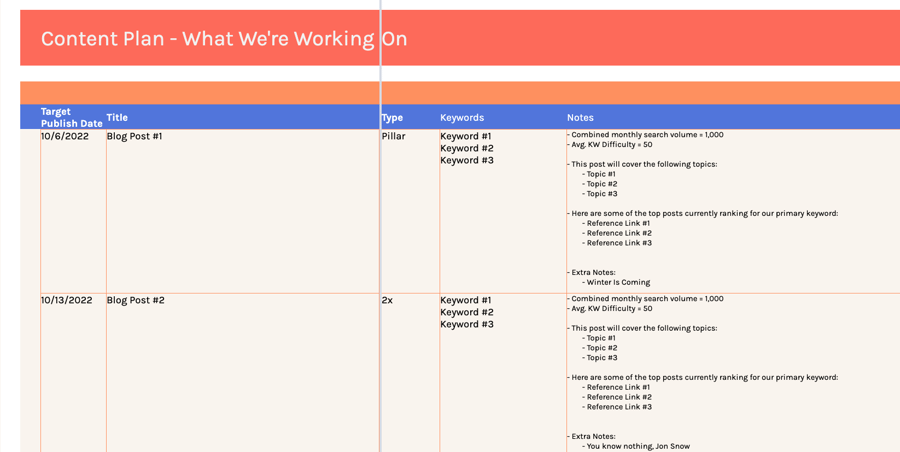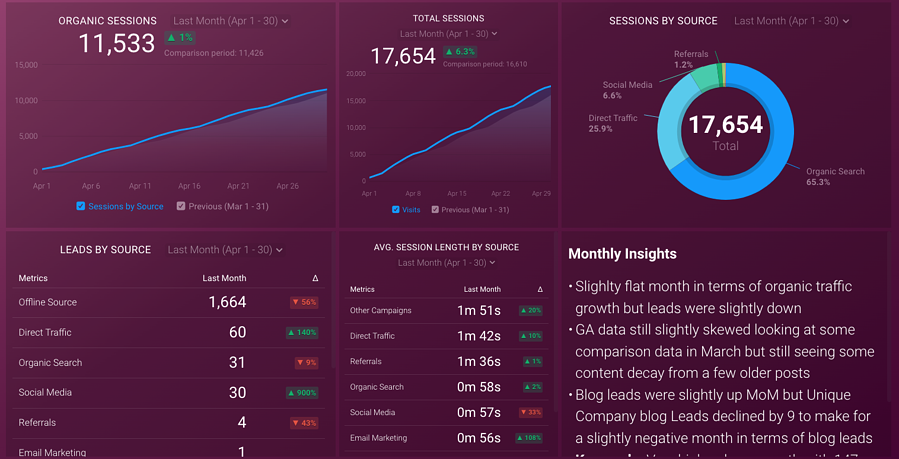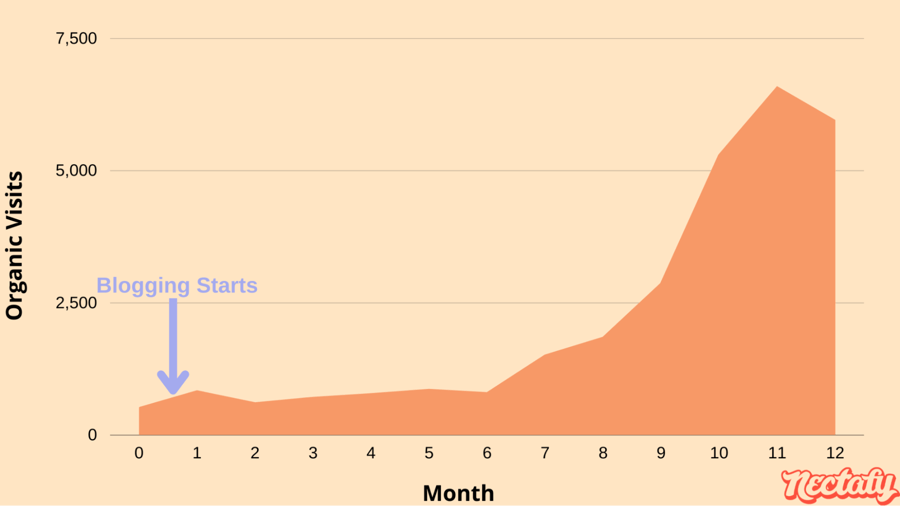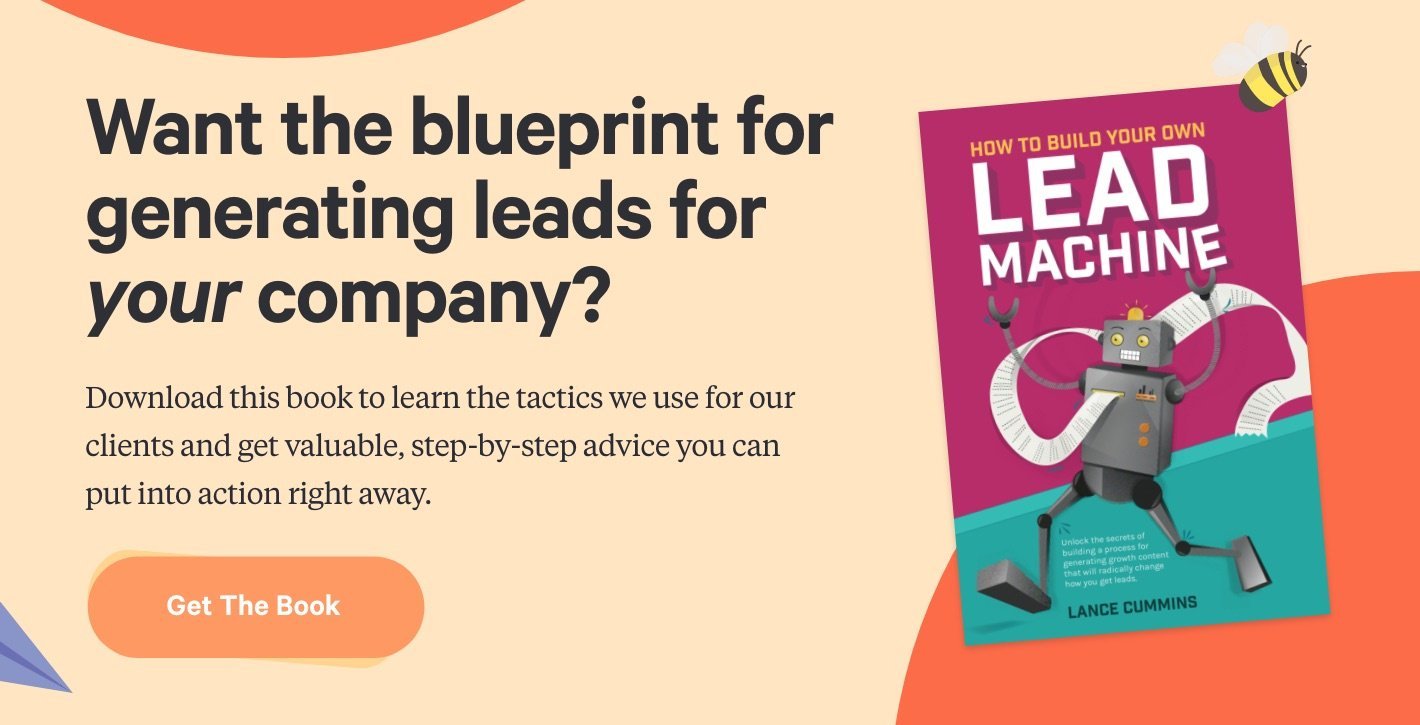How To Create A B2B Content Marketing Strategy



Let’s play a game of “Would you rather…?”
- Would you rather see an immediate (but temporary) surge in sales or build long-term brand awareness and customer loyalty?
- Would you rather spend a consistent amount of money each month to maybe get leads and traffic to your website, or invest more upfront (and less later) to build a web presence that naturally gains more leads and traffic over time?
- Would you rather pay for leads via advertising, or see your ideal audience come to you organically?
I bet you chose the latter for every single scenario. Of course you would prefer a sustainable, reputable brand that reaches the right people and has a high ROI. The question is: How can you make that happen?
The answer: By establishing a content marketing strategy that works.
In this article, I’ll walk you through exactly how to create a content marketing strategy for B2Bs that actually works. (It’s the strategy we use for our clients—and our own company—so we have the data to support it.) Let’s start from the top:
What is B2B content marketing?
From HubSpot:
“B2B (business-to-business) marketing refers to any marketing strategy or content that is geared towards a business or organization. Companies that sell products or services to other businesses or organizations (vs. consumers) typically use B2B marketing strategies.”
From Backlinko:
“B2B content marketing is the practice of producing and distributing content in order to increase brand awareness, traffic, leads and sales for business-to-business companies. Common forms of content marketing in B2B include blogging, podcasting, email newsletters and infographics.”
From our own strategist, Matt:
“B2B content marketing is simply the practice of producing and distributing content in order to increase your brand awareness, traffic, and leads from your website. It’s a way of growing your business through the form of content production.”

B2B vs. B2C Content Marketing
This article (and all the work we do at Nectafy) is geared toward B2B companies. This is important to note because marketing tactics differ for B2B and B2C companies.
- B2B marketing is intended to work over a longer period of time. B2B companies often sell goods and services like SAAS software or consulting arrangements—things that are more expensive and require more research. So in order to make a sale, B2B companies need to produce more content that answers questions and builds trust over time.
- B2C marketing is geared more toward getting people to take a step quickly and with a greater sense of urgency, because often what’s being sold are goods that can be seen as impulsive buys.
B2B content marketing has seen huge growth in the last decade, and is poised to continue in that direction. Gone are the days of interruptive, billboard-type marketing—now, more users than ever are turning to the internet to get answers that will help solve their problems. At the same time, they’re also becoming more adept at collecting information from different sources and companies and vetting their options.
Companies that are proactive about sharing information through content marketing will have the benefit of the first impression; they’ll also get to set the standard with regard to the “answer” to the customer’s problem. Today, more companies than ever are investing a lot of money in content marketing vs. other channels because:
- It’s a long-term play with a solid foundation.
- The benefits of SEO-driven blog posts accumulate over time.
- It’s a sustainable way to create an ecosystem of organic traffic.
So if you aren’t doing content marketing, you need to start today.
Right now.
Finish this article, and then get started with step number one. It can change the trajectory of your business if you can be consistent.
How To Create A B2B Content Marketing Strategy In 6 Steps
1 Identify your target audience.
Step one is to understand and clarify who you’re speaking to. You do this by creating buyer personas, which are fictional representations of your ideal audience.
At Nectafy, we create buyer personas through a series of strategic discussions, starting with you, our client. We’ll talk to the people inside your company who know your audience the best. In addition to speaking to your internal team, we interview your clients, surveying them about their business goals, challenges, needs, and wants.
This process is crucial because, in order for content marketing to be effective, this building block needs to be accurate. If you don’t have a clear target audience in mind, the following steps aren’t as likely to produce good results.
2 Identify your keyword targets.
Once we understand the persona, we move into identifying your keyword targets. Now that you know who is looking for a solution or product that relates to what you offer, you need to figure out how they’re looking for it. This is where keyword research comes in.
Our Nectafy strategists identify targets by working backwards: Based on what we know about your buyer persona, in a typical workday, what are these people searching for on search engines? What are the phrases they’re using that are most helpful for them? These are the keyword targets you should focus on.
To get the best results, start your search with broad keywords that have a lot of search volume. We use Semrush to identify larger keyword topic clusters, and then dive into the subtopics within the clusters of keywords to get more narrow keywords with less search volume. Every keyword you’re identifying should go back to your persona. You can learn more about keyword strategies here.
3 Set realistic expectations around your keywords.
When you’re trying to build authority on a certain topic, you can’t start out pursuing competitive target keywords that have a high search volume. You must start with less competitive keywords—these are typically long-tail keywords or keyword phrases that have context or specificity.
For example, business blogging is a highly competitive keyword, so you might want to start with a less competitive long-tail keyword, such as blogging for your small business. It has less competition, and therefore presents a more realistic opportunity for ranking.

We use Semrush to see keyword stats and identify terms related to keywords; then we look for keywords with lower volume or competitiveness. Finally, we create content using the long-tail keywords we’ve identified. You can learn more about this strategy in our article, SEO For Startups: 11 Tactics That Actually Work For New Websites.
How much could your company grow with growth content?
Calculate your expected growth in organic visits based on the average Nectafy client.
Get all these numbers in your inbox.
4 Structure your content plan around your keyword search intent.
First, survey the first page search results of Google with regard to the long-tail keywords you’ve found—simply search them and review the ranking articles. This will help you learn the search intent behind each piece. Google rewards the most helpful content, so see if you can identify the trends within these posts and learn why Google is making them successful. What types of articles are they? Do they contain images, graphs, videos, etc.? Use that knowledge to help you create something better than the best.
Then, after you’ve done the research portion, create a content plan that has the following things in place:
- The set list of target keywords you’re going after so you can measure the success of the content you’re creating. Are those keywords helping the article rank in Google and bring in leads?
- An outline of each piece of planned content (blog post, web page, etc.), to clarify the flow and substance of the article.
Here’s an example of what this looks like in our client spreadsheets (or what we like to call their NectaPlan):

You can see it has all the sections mentioned above, plus the “Target Publish Date” of each article so we can keep our content output consistent and organized, and the “Type” of blog post we want to create.
Check out our other article around blog post types for more information about which types of posts have worked best for us.
5. Establish your key performance indicators (KPIs).
None of these B2B content marketing strategies matter if you’re not tracking their success and making adjustments when needed. So how do you do that? Enter KPIs. The KPIs you identify will help you measure your progress in any given area. When you’re just getting started, three of the most important KPIs you should track are the following:
- Organic traffic
- Organic leads
- Keyword rankings
There are a lot of other helpful metrics you will eventually want to track, but these three are the most important to start because they gauge how well your B2B content strategy is performing. There are lots of tools you can use to measure KPIs; at Nectafy, we use Databox in our monthly reporting to clients.

Databox acts as a hub for all our monthly KPIs and allows us to pull in metrics from different data sources (like HubSpot & Google Analytics). We put everything into a singular dashboard for monthly client reporting calls, rather than bouncing around between different reporting screens across various platforms.
If you’re just starting out with your B2B content marketing efforts and don’t have that much money to spend, you can also check out Google Data Studio (a free alternative to Databox).
6 Measure your performance.
The final step is to publish your content and measure its success through (at least) the KPIs mentioned above.
As you measure and track your KPIs, remember this: Patience is a requirement. Because content marketing is a long-term play for brand awareness and traffic, it takes time to build results; if you’ve never published a blog post or you’re not producing quality content consistently, it will be more challenging to develop content authority (the yardstick Google uses to rank your content). However, if Google sees that, over time, you’re producing a lot of great content, you’ll begin to rank for the less competitive keywords you’re writing about. Eventually, you can begin to target your more competitive keywords with different types of content and have a better chance at ranking for them.
A Word About Patience
How long will it take you to begin gaining traction on your website once you employ content marketing? There’s no one-size-fits-all number, but in our experience, here’s what we’ve seen:
- From the time you produce your first piece of content, you should have 2-3 months before you see any sort of keyword traction. That doesn’t mean loads of organic traffic, but you should see your information trickle into the top 100 rankings.
- After 3–5 months, you will likely begin to see your organic traffic increase.
- After the first year of content marketing, you’ll likely see impressive results. If you are consistently producing content, you’ll see a big uptick in traffic and organic leads within 6-8 months. This is what we call the snowball effect: your traffic and keyword growth will be tremendous, and the new content you’re producing will rank faster and with more ease than what you’ve posted previously.
To give you a better idea of what 12 months of content marketing can actually lead to for a company like yours, check out this case study: From 600 to 6,000 Organic Visits In 12 Months: The B2B Blog Strategy.

What To Do Next
Don’t let old posts languish.
As you’re building organic traffic and other KPIs (leads, traffic, etc.), over time, you’ll start to see declines in some posts’ rankings—typically your older blog posts. This is called content decay. It happens because Google constantly updates and refreshes its lists; as your content gets older and your competitors publish new content, your rankings will dip.
To combat this, make sure you refresh older blog posts that are still bringing in rankings and traffic.
Provide a next step.
As you’re producing blog posts, think about what you want your reader to do next. Subscribe to your blog or mailing list? Download an offer? Give you their information for a product demo or free trial? Whatever it is, make sure you’re providing a clear call to action that paves the way for them to get to that next step. If not, your hard work in creating content won’t get you any further in terms of getting your reader to become a customer.
With that said, if you’re looking for more help in creating your B2B content marketing strategy, download our free ebook: How To Build Your Own Lead Machine. It’s a practical, step-by-step guide to making content marketing work for you.

